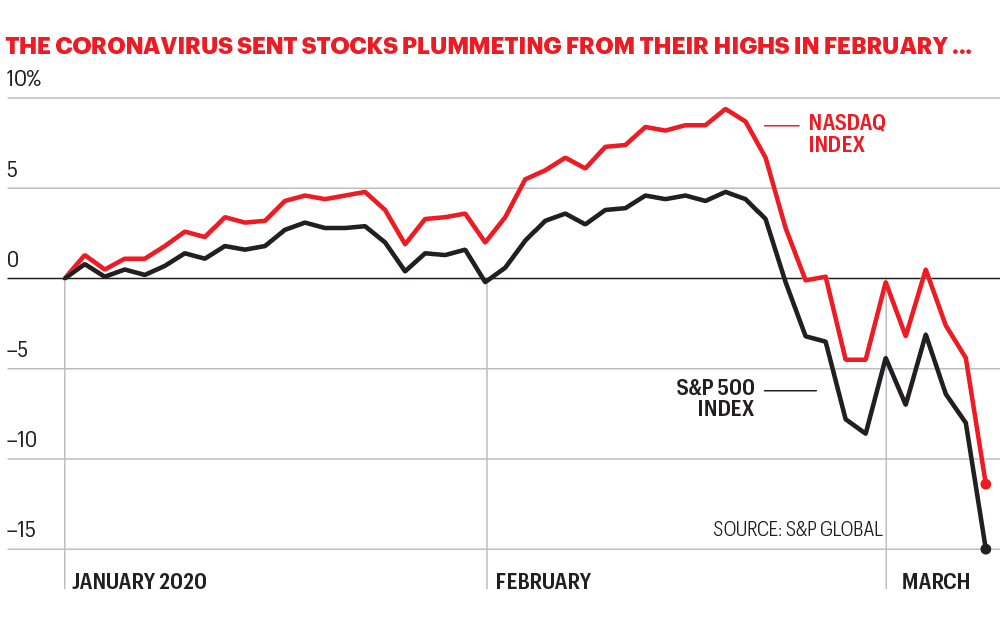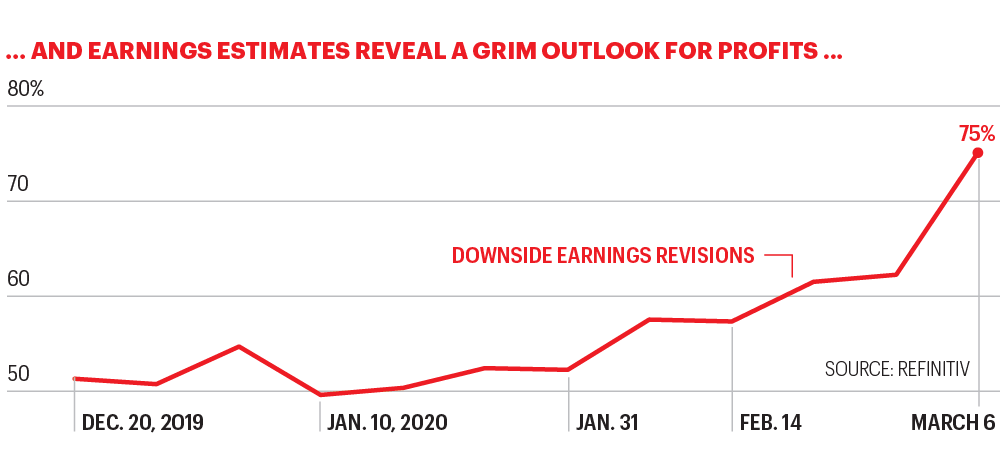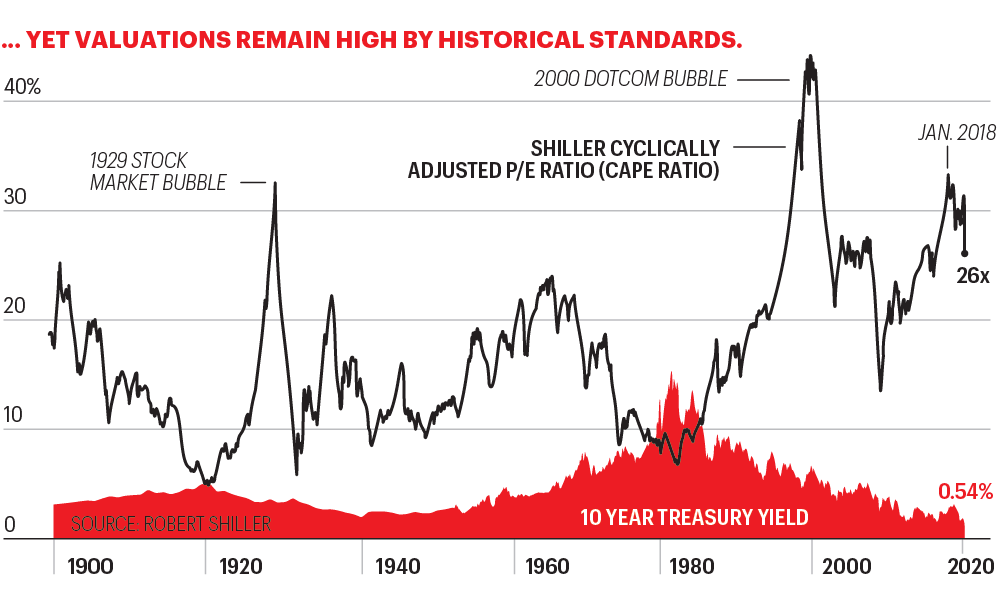
讓我們回顧一下局勢比較簡單的那段時間。
例如,,一月和二月,。盡管似乎已經(jīng)有些遙遠了,但你或許記得,,標(biāo)準(zhǔn)普爾500指數(shù)在2月19日創(chuàng)下3394點的歷史高點,。投資巨頭Capital Group的經(jīng)濟學(xué)家賈里德·弗朗茨(Jared Franz)說:“股票市場此前已經(jīng)消化了這種不溫不火的狀況,開年就出現(xiàn)較高的市盈率倍數(shù),,幾乎沒有任何緩沖,。”接著,,新冠病毒來了,。
2月底和3月,隨著新冠病毒影響的持續(xù)蔓延,,股市遭受了一系列重創(chuàng),。投資者不僅飽受不確定性的折磨,也開始重新評估之前為各種資產(chǎn)所支付的高額費用,。一旦他們開始詢問“這個市場究竟值多少錢,?”答案往往不容樂觀。嘉信理財?shù)氖紫顿Y策略師利茲·安·桑德爾斯指出:“在上個周期中,,每當(dāng)美聯(lián)儲量化寬松,,風(fēng)險資產(chǎn)的價格就會上漲,百試不爽,。然而這種情況目前出現(xiàn)了巨變,。盡管利率在下降,信貸卻在收緊,,估值因而受到打擊,。”
從目前的基本指標(biāo)看來,,有一件事是可以肯定的:即便股市反復(fù)下跌,,股價也只不過是從高得離譜降為過高。新冠病毒固然是引發(fā)當(dāng)前疑慮的催化劑,,但另一個因素也不容忽視:2019年的大部分時間里,,股價飆升,收益卻停滯不前,,造成了依賴于利潤增長的虛高估值與實際利潤增長受阻的矛盾,。弗朗茨認為,,這種矛盾已經(jīng)愈發(fā)明顯:“標(biāo)普500的收益預(yù)期已經(jīng)很低了,,且會進一步降低,因為”新冠疫情爆發(fā)“可能造成供應(yīng)中斷”。



標(biāo)普500在二月中旬達到高位,,市盈率為24.2,,根據(jù)標(biāo)普的12個月的收益預(yù)測,2020年第一季度或為140美元,。與之前20年約20的平均水平相比高出21%,;與過去70年17.5的平均水平相比則高出近40%。截至3月9日,,市盈率大幅下跌19%,,降至19.6,接近過去20年的平均水平(而過去20年的平均市盈率數(shù)字已經(jīng)算高的了),。
股票有兩種回報渠道:股息和資本收益,。我們先來看看股息。在最近的高位上,,不斷上漲的價格將收益率推至1.87%,。拋售將收益率抬高到近2.2%,但仍低于1951年以來3%以上的平均水平,。今年,,各大公司將相當(dāng)于其營收42%的資金用于派發(fā)股息。因此,,就股息而言,,投資者的風(fēng)險回報很低。
資本收益有三個驅(qū)動因素:股票回購,、利潤增長和“倍數(shù)擴張”,,也就是市盈率的上升。目前,,標(biāo)普500的成分股公司在股票回購上的支出相當(dāng)于所有不派息的收益,。(他們可以通過增加借款獲得內(nèi)部投資資金。)如果他們繼續(xù)把相當(dāng)于一半利潤以上的現(xiàn)金用于回購股票,,市場上的股票總量就會減少3%,。這就將使每股的收益相應(yīng)增加,這樣一來,,如果市盈率保持在19.6,,標(biāo)普指數(shù)將同樣上漲3%,。因此,假如目前的市盈率穩(wěn)定在19.6,,投資者將得到從股息和回購中得到總計5.2%的回報,。
但若與我們接下來要說到的問題相比,上述股息和資本收益方面的提高實在是微不足道,。
自2018年二季度開始,,各大公司的季度收益基本保持平穩(wěn),此后幾乎沒有變化,。既然新冠疫情對收益的打擊有可能比分析師們預(yù)計的更嚴重,,那么目前即便沒有增長,也算是好消息了,。
此外,,目前的利潤仍比三年前高出40%。因此,,目前超過19的市盈率其實是高估了,,很有可能只是盈利泡沫而已。想要知道價值是否正常,,可以參考諾貝爾獎得主,、耶魯大學(xué)教授羅伯特·希勒(Robert Shiller)提出的CAPE,即周期調(diào)整市盈率,。
即使在大幅下跌之后,,希勒市盈率(即周期調(diào)整市盈率)仍達到了26倍。這個數(shù)字從未長時間保持在這么高的水平,,之前兩次達到更高水平分別是1929年的市場崩盤和2000年的科技泡沫,。如果以希勒市盈率為基準(zhǔn)衡量的估值到2021年恢復(fù)正常,標(biāo)準(zhǔn)普爾500指數(shù)還得進一步下跌22%,,至2150點,。
有什么是我們能確定的嗎?回歸均值是市場上一股強大的力量——而且常常能如愿以償,。(財富中文網(wǎng))
譯者:胡萌琦
讓我們回顧一下局勢比較簡單的那段時間,。
例如,一月和二月,。盡管似乎已經(jīng)有些遙遠了,,但你或許記得,標(biāo)準(zhǔn)普爾500指數(shù)在2月19日創(chuàng)下3394點的歷史高點,。投資巨頭Capital Group的經(jīng)濟學(xué)家賈里德·弗朗茨(Jared Franz)說:“股票市場此前已經(jīng)消化了這種不溫不火的狀況,,開年就出現(xiàn)較高的市盈率倍數(shù),幾乎沒有任何緩沖,?!苯又?,新冠病毒來了。
2月底和3月,,隨著新冠病毒影響的持續(xù)蔓延,股市遭受了一系列重創(chuàng),。投資者不僅飽受不確定性的折磨,,也開始重新評估之前為各種資產(chǎn)所支付的高額費用。一旦他們開始詢問“這個市場究竟值多少錢,?”答案往往不容樂觀,。嘉信理財?shù)氖紫顿Y策略師利茲·安·桑德爾斯指出:“在上個周期中,每當(dāng)美聯(lián)儲量化寬松,,風(fēng)險資產(chǎn)的價格就會上漲,,百試不爽。然而這種情況目前出現(xiàn)了巨變,。盡管利率在下降,,信貸卻在收緊,估值因而受到打擊,?!?/p>
從目前的基本指標(biāo)看來,有一件事是可以肯定的:即便股市反復(fù)下跌,,股價也只不過是從高得離譜降為過高,。新冠病毒固然是引發(fā)當(dāng)前疑慮的催化劑,但另一個因素也不容忽視:2019年的大部分時間里,,股價飆升,,收益卻停滯不前,造成了依賴于利潤增長的虛高估值與實際利潤增長受阻的矛盾,。弗朗茨認為,,這種矛盾已經(jīng)愈發(fā)明顯:“標(biāo)普500的收益預(yù)期已經(jīng)很低了,且會進一步降低,,因為”新冠疫情爆發(fā)“可能造成供應(yīng)中斷”,。
標(biāo)普500在二月中旬達到高位,市盈率為24.2,,根據(jù)標(biāo)普的12個月的收益預(yù)測,,2020年第一季度或為140美元。與之前20年約20的平均水平相比高出21%,;與過去70年17.5的平均水平相比則高出近40%,。截至3月9日,市盈率大幅下跌19%,,降至19.6,,接近過去20年的平均水平(而過去20年的平均市盈率數(shù)字已經(jīng)算高的了),。
股票有兩種回報渠道:股息和資本收益。我們先來看看股息,。在最近的高位上,,不斷上漲的價格將收益率推至1.87%。拋售將收益率抬高到近2.2%,,但仍低于1951年以來3%以上的平均水平,。今年,各大公司將相當(dāng)于其營收42%的資金用于派發(fā)股息,。因此,,就股息而言,投資者的風(fēng)險回報很低,。
資本收益有三個驅(qū)動因素:股票回購,、利潤增長和“倍數(shù)擴張”,也就是市盈率的上升,。目前,,標(biāo)普500的成分股公司在股票回購上的支出相當(dāng)于所有不派息的收益。(他們可以通過增加借款獲得內(nèi)部投資資金,。)如果他們繼續(xù)把相當(dāng)于一半利潤以上的現(xiàn)金用于回購股票,,市場上的股票總量就會減少3%。這就將使每股的收益相應(yīng)增加,,這樣一來,,如果市盈率保持在19.6,標(biāo)普指數(shù)將同樣上漲3%,。因此,,假如目前的市盈率穩(wěn)定在19.6,投資者將得到從股息和回購中得到總計5.2%的回報,。
但若與我們接下來要說到的問題相比,,上述股息和資本收益方面的提高實在是微不足道。
自2018年二季度開始,,各大公司的季度收益基本保持平穩(wěn),,此后幾乎沒有變化。既然新冠疫情對收益的打擊有可能比分析師們預(yù)計的更嚴重,,那么目前即便沒有增長,,也算是好消息了。
此外,,目前的利潤仍比三年前高出40%,。因此,目前超過19的市盈率其實是高估了,很有可能只是盈利泡沫而已,。想要知道價值是否正常,,可以參考諾貝爾獎得主、耶魯大學(xué)教授羅伯特·希勒(Robert Shiller)提出的CAPE,,即周期調(diào)整市盈率,。
即使在大幅下跌之后,希勒市盈率(即周期調(diào)整市盈率)仍達到了26倍,。這個數(shù)字從未長時間保持在這么高的水平,,之前兩次達到更高水平分別是1929年的市場崩盤和2000年的科技泡沫。如果以希勒市盈率為基準(zhǔn)衡量的估值到2021年恢復(fù)正常,,標(biāo)準(zhǔn)普爾500指數(shù)還得進一步下跌22%,,至2150點,。
有什么是我們能確定的嗎,?回歸均值是市場上一股強大的力量——而且常常能如愿以償。(財富中文網(wǎng))
譯者:胡萌琦
Think back to a simpler time.
For instance, January and February. Though it seems distant now, the S&P 500 hit its all-time high of 3394 on Feb. 19. “The stock markets previously had priced in a Goldilocks scenario and entered the year with an elevated price-to-earnings multiple, providing little cushion,” says Jared Franz, an economist at investment giant Capital Group. Then came the coronavirus.
As the effects of the coronavirus continued to spread throughout late February and March, the stock market sustained a series of blows. Investors were not only plagued by uncertainty, they also began to reassess the rich premiums they had been paying for all sorts of assets. And once they started asking “How much is this market really worth?” the answer was bleak indeed. “In the past cycle, the elixir was that when the Fed eases, the price of risk assets goes up,” says Liz Ann Sonders, chief investment strategist at Charles Schwab. “That narrative is now undergoing an epic shift. Credit is tightening even though rates are falling, and that’s hitting valuations.”
The bedrock metrics show one thing for sure: Even after the repeated drops, stocks have simply gone from outrageously overpriced to overpriced. The coronavirus was the catalyst that kicked off the current cycle of doubt, but there’s another factor at play too: For most of 2019, stock prices roared ahead while earnings stalled, creating a mismatch between inflated valuations dependent on rising profits and profits that hit a wall. And, says Franz, that wall has only grown higher: “Earnings expectations for the S&P 500 were already muted and have come down further given potential supply disruptions” caused by the coronavirus outbreak.
At the S&P 500’s mid-February summit, the price-to-earnings ratio stood at 24.2, based on S&P projected 12-month trailing earnings, through Q1 2020, of $140. That’s 21% above its 20-year average of roughly 20, and almost 40% over the 70-year norm of 17.5. The steep drop of 19% through March 9 lowered the multiple to 19.6—near the average of the past two decades, an era in which they have been richly priced.
As always, equities deliver returns in two packages: dividends and capital gains. Let’s start with dividends. At the recent peak, rising prices had driven the yield to just 1.87%. The selloff has lifted yields to almost 2.2%, better but still below the average of over 3% since 1951. This year, companies spent an amount equal to 42% of their earnings on those dividends. So, on the dividend front, investors are being poorly rewarded for their risk.
On the capital gains side, there are three driving factors: share buybacks, growth in profits, and “multiple expansion,” or a rising price-to-earnings ratio. Today, S&P 500 companies are spending the equivalent of all earnings that don’t go to dividends on buybacks. (They are able to fund internal investment through added borrowing.) If the S&P continues to steer the cash equivalent of more than half its profits to repurchases, share counts will fall by 3.0%. That would lift earnings per share by a like amount, so if the P/E—the figure by which you multiply those earnings to get the share price—stays at 19.6, the S&P index will advance by the same 3%. Hence, if the current P/E of 19.6 holds, you’ll get a combined 5.2% return from dividends and buybacks alone.
But these improvements when it comes to dividends and capital gains are minor when compared with the abyss below.
Quarterly earnings went flat starting in Q2 of 2018 and have barely budged since then. With the coronavirus likely to hammer earnings a lot harder than analysts are positing, even no growth now sounds rosy.
And profits are still 40% above where they were three years ago. So today’s 19-plus P/E is putting a high valuation on what looks like an earnings bubble. For confirmation that values are out of whack, look at the CAPE, or cyclically adjusted price/earnings ratio, a measure developed by Robert Shiller, a Yale professor and Nobel laureate. Shiller adjusts the multiple by using a 10-year average of inflation-adjusted profits, a methodology that smooths the lurching swings that make equities look cheap when profits spike and pricey when earnings drop.
Even after the big drop, the Shiller P/E registers 26. It has never stayed at a level that high for long, and the only times it’s been higher were the run-up to the market crash in 1929 and the tech bubble of 2000. If valuations, measured by the Shiller benchmark, return to normal by 2021, the S&P would fall an additional 22%, to 2150.
One thing we can be sure of? Reversion to the mean is a powerful force in the markets—and it usually prevails.?






